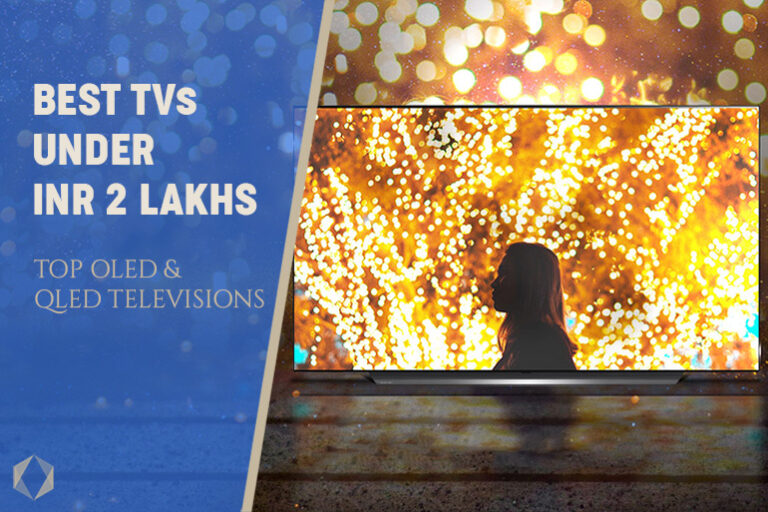Televisions are an important part of the living room. It would not be unfair to say that they bring people together. They aren’t just another gadget occupying space but define the character of the room put them in.
Well, of course, our job is to help you find a good television and in this post we will look at some of the best televisions 55 inches across diagonally that can fit well in your living room. We will only be looking at OLED and high-end QLED televisions since they are pretty much the best of what technology has to offer. These high-end windows bring images to life with their popping accurate colors and deep contrast. You can pretty much expect features like 4K, the latest operating system, and stunning picture quality.
However, here are a few other things you need to keep in mind before we look at the various models under Rs 200,000 (2 lakhs).
PREREAD
Panel type: It is easy to get confused between QLED and OLED given the similar name and price tag. But, on the contrary, these are quite different technologies. QLED, short for Quantum LED, is a type of LED that was popularized by Samsung and can be seen on a bunch of different TV models from manufacturers like Samsung, TCL, and Vizio.
QLED panels still use the backlight technology seen in regular LEDs with an extra film of tiny phosphorescent crystals that glow when hit with light. This allows to produce much accurate colors on the screen, unlike traditional LCDs. However, similar to traditional LEDs, QLED struggles with producing deep blacks.
OLED, on the other hand, is a different technology altogether. Each pixel on an OLED panel can produce its own light and color, meaning, it doesn’t require any backlight. Not only does this produce excellent colors, but it also allows individual pixels to shut down when creating blacks, thus offering much deeper blacks and much higher contrast.
In short, OLED televisions are better than QLED at contrast and producing blacks. They also excel in other areas such as response time and refresh rate. QLEDs beat OLEDs as far as peak brightness is concerned. Also, QLED TVs are much cheaper.
Refresh rate: Most of these televisions support 60Hz refresh rate at 4K and that should be enough for movie and TV viewing experience. However, gamers might want to push that further and there are some models that can push 4K at 120FPS. That requires HDMI 2.1 standard which isn’t really as prevalent as you’d imagine. Only 2020 models and some LG models from 2019 support the new HDMI standard which is essential for 120fps 4K gaming.
There’s also variable refresh rate that allows the television to replicate the refresh rate pumped out by the PC or the console. Most TVs don’t support it but a few models which do have been called out below.
Most OLEDs are built the same but QLEDs aren’t: The thing with OLED panels is that they are pretty much consistent. You won’t find two OLED models with a lot of difference in quality of panels. Whatever difference that may exist would instead be driven by the processing power of the chip inside.
That’s not true for QLED panels though. Since QLED are essentially LCD panels, there’s a significant difference in quality as the price goes up. Things like the number of dimming areas behind the screen, backlit system, viewing angle, and screen reflectivity change as the price of the TV increases.
So now that you’ve had a basic brief on the technology, let us look at some of the best models in this budget below.
LG OLED55CXPTA
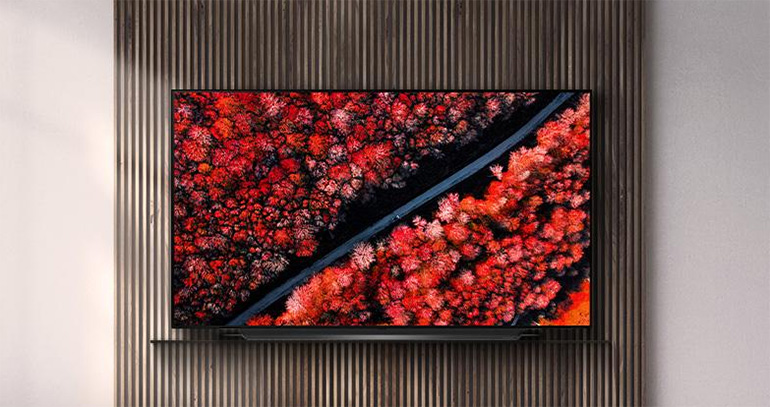

LG is usually considered amongst the best, if not the best, when it comes to OLED televisions. It’s only fair since LG also sells its OLED panels to other manufacturers like Sony.
The OLED55CXPTA is from the updated lineup for 2020 and builds on the feature list that its predecessor had to offer from 2019. These include 4K resolution (you knew that already), support for HDR 10 Pro and Dolby Vision HDR, an α9 Gen 3 Intelligent Processor, and the ability to play 4K@120P, 10-bit content.
On the audio side, you get 40W speakers and a 20W subwoofer system. AI Acoustic Tuning setting allows you to calibrate the audio according to the dimensions of the room by taking inputs from the microphone on the remote. It also supports Dolby Atmos on its 2.2 setup.
Being a smart TV, it comes with LG’s own webOS operating system. While it may not be able to compete with Android or Samsung’s Tizen in terms of app count, you will find most of the apps already present on the app store. For those missing, you can consider a streaming device to fill that gap. The television also supports both Google and Amazon Alexa voice assistants.
The remote senses your hand motions and brings up a pointer on the screen even when you’re not pointing the remote at it. It’s pretty convenient when going through the settings or using an OTT app.
Not much has changed when you compare to last year’s C9 though. That’s not really a bad thing though, since the C9 was much ahead of the competition even in 2019. Major changes include a next-gen processor, Dolby Vision IQ support. G-Sync certification, support for black frame insertion at 120Hz (C9 only supported BFI at up to 60Hz), and webOS 5.0. Similar to the C9, you get Alexa built-in, Apple AirPlay2, and HDMI 2.1 support. The last one should be huge for gamers, especially those looking for next-gen gaming.
LG claims the new processor inside allows for better upscaling and light adjustment. What makes the TV standout though is support for HDMI 2.1 which unlocks a whole bunch of features such as 4K 120fps gaming, variable refresh rate (VRR) and automatic low latency mode, and enhanced audio through eARC which can support up to 32 audio channels. The other good news is that there are 4 of these ports so your devices won’t be fighting for the same port.
You can expect top-notch display quality with LG OLEDs being the best in the industry and that’s something most of the reviews call out. Peak brightness for HDR content goes up till 740 nits, which, while may not compare to QLEDs, is adequate.
Speaking about the physical dimensions, CX’s panel is less than a quarter-inch thick, reaching under 2 inches towards the bottom. It weighs 18.9 kilos without the stand. Adding the stand takes the weight to 23kg.
All in all, we see the LG OLED55CXPTA as a great option. Being the best LG has to offer, it has most of the bells and whistles you would require and offers great picture quality across movies and gaming. The only thing it lacks is support for HDR10+, which honestly, doesn’t look like much of a deal-breaker.
- One of the best OLED panels with great HDR and contrast
- Support for HDMI 2.1
- 4K 120Hz and VRR support
- Potential screen burn-in issues with OLED panels
- Lower peak brightness compared to QLED TVs
LG OLED55BXPTA


If you look at the specs, the LG OLED55BX is more or less similar to the CX. It has got the same OLED panel as its more expensive sibling. Yet there are some subtle differences that justify the higher price tag on the CX.
Talking about the things that the BX has in common with the CX first, both come with a 55 inch 4K OLED panel. Both offer the same webOS experience. The BX also offers 4K 120Hz and HDMI 2.1 support just like the CX. The audio also remains the same as the CX. Finally, there’s also support for VRR and NVIDIA’s G-Sync.
You also get the same LG Magic Remote, which, as we mentioned before, it a true joy to use.
What makes the BX different is the slightly less powerful α7 Gen 3 processor. While numerous reviews point that it does not make much of a difference, CX has slightly better lighting control and contrast. The CX also has a slightly more bright panel. At peak HDR brightness, the BX only manages to hit close to 400 nits, while the CX goes up to 740 nits. Lastly, only HDMI 3 & 4 on the BX support the new 2.1 standard.
Our advice? If the price gap is significant, go for the BX instead. The marginal improvement in picture quality isn’t worth an extra $500.
- One of the best OLED panels with great HDR and contrast
- Support for HDMI 2.1
- 4K 120Hz and VRR support
- Potential screen burn-in issues with OLED panels
- Lower peak brightness compared to QLED TVs and even CX
SONY 55A8G
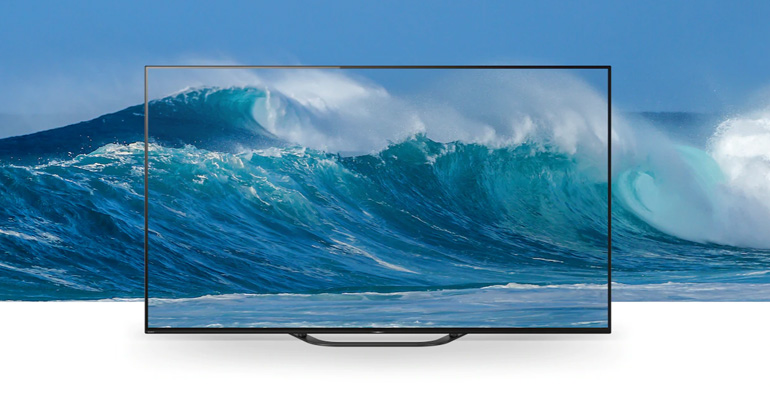

Next on the list is another OLED champion from Sony released in 2019. The 55A8G comes with top of the line features including 4K resolution, Dolby Vision, HDR10, HLG playback capability, and Android Oreo with built-in Google Assistant.
The OLED panel here has been sourced from LG so, unsurprisingly, it is top-notch. The blacks are deep as you would expect and the colors shine out really well. Although, the default colors are a little on the cool side and might require some calibration. The peak brightness goes up to 800 nits which, while perfectly adequate, cannot be compared to QLED televisions from Samsung. However, like the LG C9, it lacks support for HDR 10+.
For audio, Sony uses proprietary Sony’s Acoustic Surface Audio which uses actuators affixed to the back of the TV to create sound using the screen. In layman’s terms, the technology gives the illusion of the voice coming from the part of the screen where it is emanating from. The effect seems to hold its own in close spaces but might struggle a little in large open rooms.
While console games should be largely satisfied with the TV’s performance, the 55A8G does lack some features seen on the LG C9. For one, the refresh rate maxes out at 60Hz at 4K. There’s no HDMI 2.1 support either that could have allowed the higher refresh rate. There’s no support for any screen syncing tech like AMD FreeSync or Nvidia G-Sync for VRR. Input lag is also a little on the higher side at 40ms, which is not the best that we have seen in the market.
To conclude, the A8G is an excellent TV with the ability to reproduce colors and contrast excellently on the screen. While it should cover the needs of most people who only watch movies and media content on the television, we feel that gamers should be better off with the LG C9, which is not only better, but also cheaper.
- One of the best OLED panels with great HDR and contrast
- Acoustic Surface Audio
- Android TV with possibly the biggest app library
- Potential screen burn-in issues with OLED panels
- Lower peak brightness compared to QLED TVs
- Higher input lag and missing HDMI 2.1 support
Samsung 55Q95T
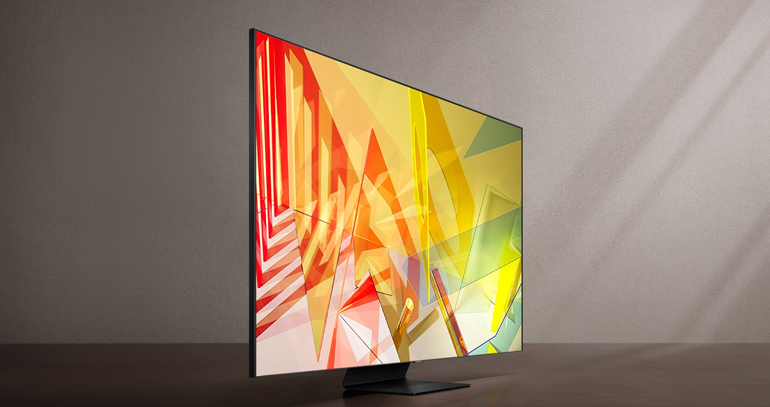

Samsung has taken a different road compared to Sony or LG and offers its best as QLED instead of OLED TVs. Now, don’t get us wrong, QLED technology can be excellent too. It’s just we find OLED to offer much better picture quality.
While the Q95 is the successor to the Q90 from 2019, it isn’t really as Samsung has shifted its focus to 8K TVs. That said, it’s still a good piece of technology with ost bells and whistles.
Like most Samsung TVs, the design is something to behold. The television is truly slim. And we don’t mean just at the top. Thanks to One Connect box, which is a separate unit housing all the ports and cables, the main television set is a monolith of uniform thickness that is connected externally with just a single cable. This makes the whole setup extremely neat, especially, when you mount it on a wall.
The One Connect box houses 4 HDMI ports, out of which, one is capable of supporting eARC, while the other can support 4K/120Hz, VRR, and ALLM (auto low-latency mode). While the HDMI ports lack 2.1 certification, Samsung says they meet every technical specification and requirement. Other connectivity features include USB ports, WiFi, Bluetooth and support for Apple AirPlay 2.
The 55Q95T features a 55 inch 4K QLED panel with direct full-array backlight that supports local dimming in up to 120 zones. Where it beats the OLEDs clearly is in brightly lit rooms and settings where the QLED panels can deliver up to 1700 nits peak brightness in real-world use. It also supports a wide array of HDR standards, including HDR10+ but misses out on Dolby Vision, which is arguably better than the HDR10+. That said, the TV produces excellent HDR content with deep blacks and brightly lit details. The motion smoothness has also been improved over the Q90. All in all, the picture quality is excellent and the blacks almost match those seen on the OLED panels.
Samsung has also added anti-reflection screen and Ultra Viewing Angle technology to improve the viewing experience. Gamers should rejoice since the Q80 offers a variable refresh rate (VRR) and has one of the best input lag in the market (10ms), well ahead of the OLED panels. There’s support for AMD’s Freesync but G-Sync certification is still in the process.
The TV comes with Tizen which is Samsung’s homegrown answer to Android. You don’t need to worry much since you will find most of the most frequently used apps on the app store.
On the audio front, you get a total of six speakers for a combined output of 60W along with a subwoofer. The processor inside the television can optimize the audio experience for your room by taking inputs from the microphone on the remote. Newly introduced Object Tracking Sound (OTS) uses six speakers and 60W of amplification for a more immersive experience.
There are a few things that are missing though. The lack of Dolby Vision is a sore point, given the standard is supported on a number of leading streaming services. Also, Samsung is using 8-bit panels on its 2020 4K range and reserving 10-bit panels for 8K. Audio also lacks Dolby Atmos support, which a number of competitors offer.
- High peak brightness
- Support for VRR
- Low input lag
- Audio performance
- Inferior contrast compared to OLED
- Missing support for Dolby Vision
Samsung 55Q80R/55Q80RAK
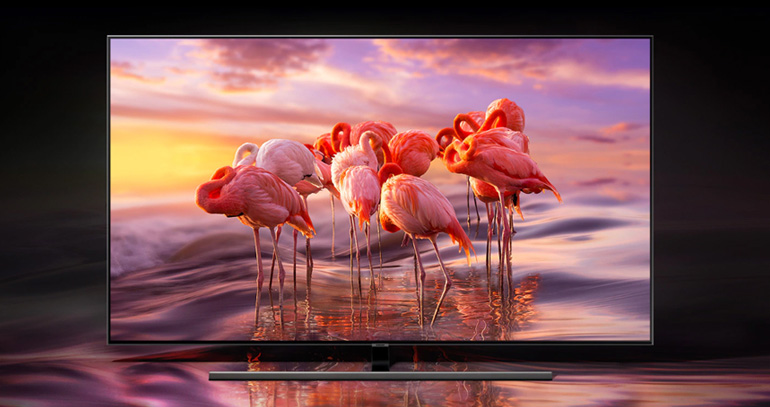

Samsung has taken a different road compared to Sony or LG and offers its best as QLED instead of OLED TVs. Don’t get us wrong, QLED technology can be excellent too. It’s just we find OLED to offer much better picture quality.
The 55Q80RAK features a 55 inch 4K QLED panel with direct full-array backlight that supports local dimming in close to 90 zones. It beats the OLEDs clearly in brightly lit rooms and settings where the QLED panels can deliver up to 1,250 nits peak brightness. It also supports a wide array of HDR standards, including HDR10+. That said, it misses out on Dolby Vision, which is arguably better than the HDR10+. Also, people concerned with screen burn-in on OLEDs can rest assured with this unit since burn-in is prevalent in OLED panels.
Gamers should rejoice since the Q80 offers a variable refresh rate (VRR). It also has one of the best input lag in the market (15-17ms) which is well ahead of the OLED panels.
The TV comes with Tizen which is Samsung’s homegrown answer to Android. You don’t need to worry much since you will find most of the most frequently used apps on the app store.
On the audio front, you get two speakers for a combined output of 40W along with a subwoofer.
However, there are a few areas where the Samsung 55Q80R does fall behind. It only supports HDMI 2.0, which means there’s no support for 4K 120Hz or eARC. Also, the display, while good, doesn’t hold a candle to OLED panels when comparing contrast and the ability to create blacks. The lack of Dolby Vision is a sore point as well. The reviews also mention room for improvement in the native audio
- High peak brightness
- Support for VRR
- Low input lag
- Inferior contrast compared to OLED
- Missing support for Dolby Vision
- High price in India
MODELS WE INTENTIONALLY LEFT OUT
Anything before 2019: Technology moves fast and 2 years is a lot of time for things to have changed considerably. We have left out televisions from before 2019 since either most of them have been discontinued or their successors offer much better features for the same price.
Samsung Q70: A QLED from Samsung which sits below the Q80 in the lineup. While it’s a decent television, it doesn’t stand to the big boys. From the reviews, we have gathered that the viewing angle is poor and the surface is rather reflective. The HDR while great doesn’t stand to the other models on the list. The local dimming, while present, is inferior to OLEDs on the list.
Samsung The Frame: The Frame is something that definitely looks like a piece of art more than a television. This one is a QLED again and comes with a customizable bezel. However, brightness levels are much lower compared to the Q80. The color accuracy is also a little off the mark. Those are good enough reasons in our book to not have it here.


